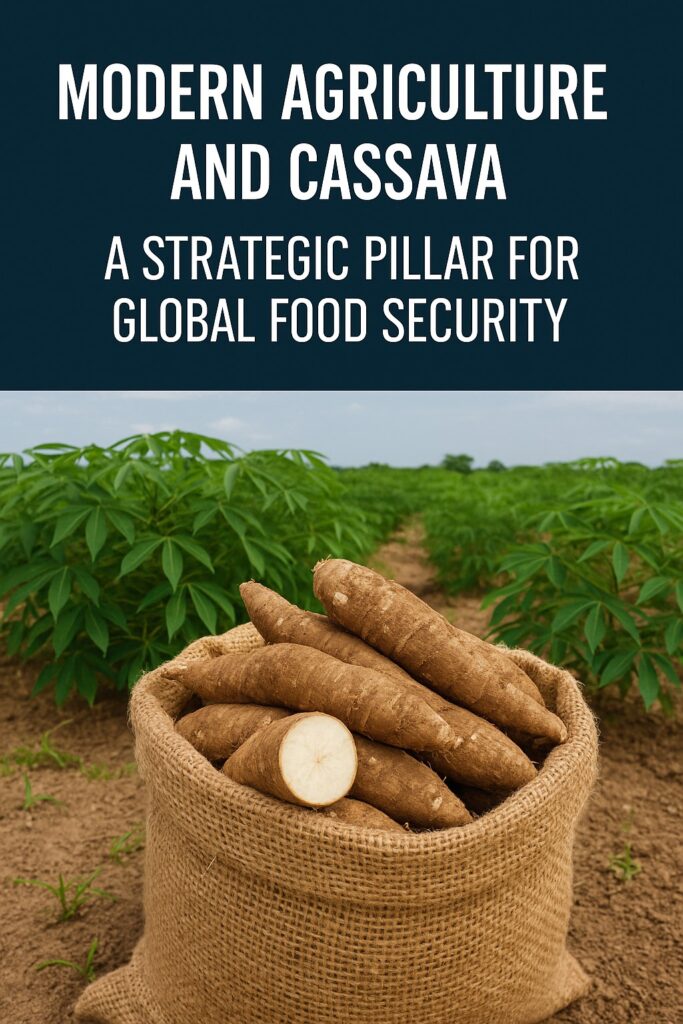Introduction: From African Fields to Global Tables
Human history has always revolved around agriculture. It feeds populations, shapes societies, and defines geopolitical balances. Today, as the world faces the triple challenge of climate change, population growth, and trade tensions, one crop is regaining attention: cassava.
From Lagos to Kinshasa, cassava is a staple on every African table. It feeds more than 800 million people worldwide. Yet, its potential goes far beyond traditional consumption: gluten-free flour, industrial starch, bioethanol, animal feed, even cosmetics and pharmaceuticals.
To unlock this potential, Africa must transition from subsistence farming to modern agriculture, supported by innovation, mechanization, and local transformation.
1. Cassava: A Crop of Resilience
Cassava is unique because of its resilience:
- It grows in poor soils.
- It resists prolonged droughts.
- It can remain underground for up to two years before harvest, acting as a natural food reserve.
In a world of increasing climate instability, cassava is a strategic crop. Where other crops fail, cassava survives.
2. A Product with Multiple Uses
a) Human consumption
- Gluten-free flour for the baking industry.
- Starch as a natural thickener.
- Traditional African products adapted for global markets.
b) Animal feed
Cassava flour and by-products provide a sustainable alternative to maize for livestock.
c) Industry and energy
- Bioethanol production from cassava starch.
- Uses in paper, cardboard, and adhesives.
- Applications in cosmetics and pharmaceuticals.
3. Modern Agriculture as a Lever
To transform cassava into a global commodity, modern agriculture is essential:
- Mechanization: tractors, planters, and harvesters tailored to cassava.
- Scientific research: improved varieties resistant to pests and diseases.
- Smart irrigation to boost yields.
- Local processing into high-value finished products.
4. The Role of the DRC and the Cassava Institute
The Democratic Republic of Congo (DRC) holds nearly 30% of Africa’s arable land. With strategic investment, the country can become the global leader in cassava.
This is the mission of the Eyano Cassava Institute:
- Training farmers in modern agricultural techniques.
- Industrializing local processing.
- Building international partnerships to export flour, starch, and bioethanol.
- Creating millions of jobs for African youth.
5. A Response to the Global Food Crisis
As the FAO warns of increasing global food insecurity, cassava offers a global solution:
- Securing food supply in Africa.
- Providing a sustainable alternative to imported cereals.
- Stabilizing international market prices.
6. Challenges Ahead
- Financing: mechanization and transformation require capital.
- Infrastructure: roads, energy, and storage facilities.
- Standardization: meeting international export standards.
- Political will: making agriculture a top national priority.
Conclusion: Cassava as a Symbol of Sovereignty
Modern agriculture is not only about productivity—it is about sovereignty and dignity.
Cassava, once considered a survival crop, can become the strategic product of the 21st century. But this requires vision: transforming African fields into a driver of global prosperity.
The future of global food security may well depend on Africa’s cassava fields.
✍️
Augustin Kazadi-Cilumbayi
President & CEO
Eyano Publishing
📧 contact@eyanoexpress.com
📞 US/Canada: +1 800 955 0153 | International: +1 613 882 0555
🌐 www.eyanoexpress.com
